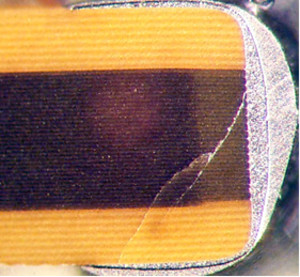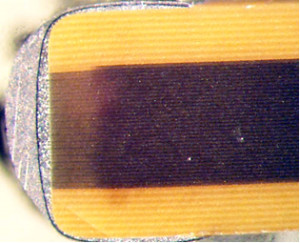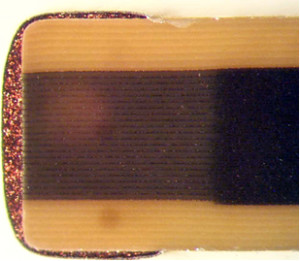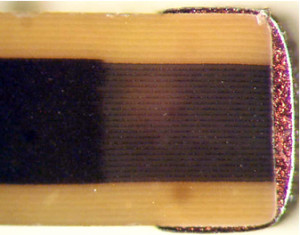Capacitor Terminal Crack
Gideon Analytical Laboratories received 19 multilayered ceramic capacitors (MLCCs). MLCCs have a ceramic dielectric, a ceramic or lacquered coating, a metalized electrode, and connecting terminals. Ceramic capacitors, in particular, MLCCs, are ubiquitous in all kinds of electrical equipment. Some of the MLCCs Gideon received were to test quality control, some were to test process evaluation immediately after wave solder, and some were failures in the field. The objective was to determine where these failures were entering the product and the cause of the failures.
Gideon Analytical Laboratories commenced failure analysis. All capacitors were electrically tested initially to determine whether the MLCC was indeed a failure. Measurements were taken in capacitance and leakage, and the MLCCs were examined for cracks. This type of MLCC should have leakage current in the gigaohm range. The capacitors were cross-sectioned to reveal internal damage caused by manufacturing.
Cross section the MLCCs revealed important results. The first picture directly below is of a new MLCC and like the other new MLCCs, showed no cracks or anomalies. The second picture below is of one of the failed MLCCs, both sides have terminal cracks. In this capacitor, the left side does not enter the active electrode region and therefore was not a contributor to the leakage current.
Gideon Analytical Laboratories drew some very important conclusions. Since the new MLCC tested well electrically and showed no cracks upon cross-section, it would suggest that the cracks are being induced during the board assembly process. This can happen by handling after wave solder or during panelization where board flexing is common.
Failure analysis provided by Gideon Analytical Laboratories can assist companies in the electronics industry in a variety of ways. This information can help them solve problems in design, production, or in the field. This information can help companies fix problems, or ensure that problems do not happen in the first place. Failure analysis can save companies enormous time and money.

Terminal crack which bisects the two electrodes

Terminal Crack

Open designed MLCC

Open designed